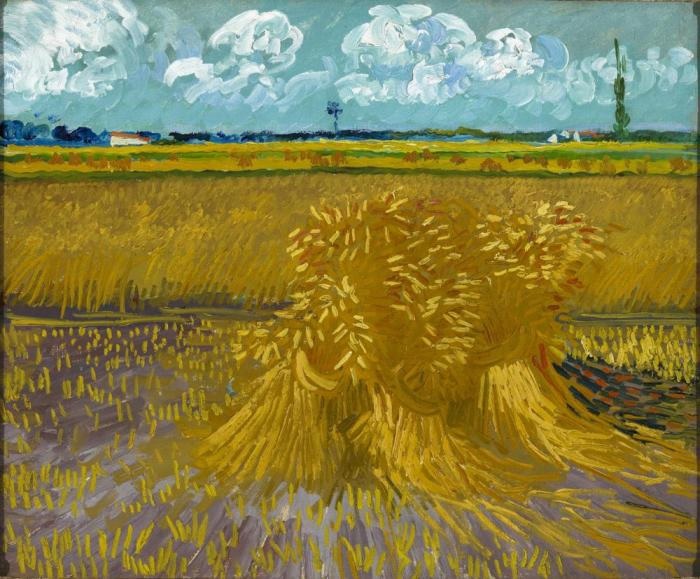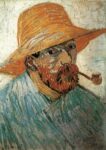
Vincent Van Gogh
Dutch, 1853-1890 (active France)
The Wheatfield, 1888
oil on canvas
21 3/4 x 26 1/4 in.
Honolulu Museum of Art, Gift of Mrs. Richard A. Cooke and Family in memory of Richard A. Cooke, 1946

Van Gogh - Self-Portrait, June 1888
“I am working on a new subject, fields green and yellow as far as the eye can reach. I have already drawn it twice, and I am starting it again as a painting; it is exactly like a Salomon Konink – you know, the pupil of Rembrandt who painted vast level plains. Or it is like Michel, or like Jules Dupré – but anyway it is very different from rose gardens.” - Letter to Theo, 12 June 1888
COMMENTS
In February 1888, Vincent van Gogh moved from Paris to Arles, a small town on the Rhône River in the South of France. In Arles, all that had influenced him in Paris--Impressionism, Neo-Impressionism, and Japanese prints--coalesced into a mature style marked by energetic, relief-like impasto and riotous, ebullient color. Wheat Field belongs to the artist's "Harvest" series, a group of ten paintings from the last half of June 1888. Distinct horizontal compositional bands lead the eye from the sheaves in the foreground to the rows of wheat in the middle ground, to the trees and houses on the horizon and the sky above. Like his friend and fellow Post-Impressionist Paul Gauguin, van Gogh emphasized personal expression over material reality, and in doing so anticipated twentieth-century Modernism.
- Honolulu Museum of Art, 2021
This composition is organized on a strictly planar base. Horizontal bands lead the eye from stubble to uncut wheat, to more sheaves of wheat and stubble, and finally to horizon and sky. The self-containment of each band is broken only by the sheaves in the foreground and the two horizon-line trees.
In this landscape without figures, the foreground sheaves almost become human presences. Substitute a sower, emphasize the standing wheat, retain the farmhouse and trees, and “The Sower” results. In the foreground, light clips the ears of wheat, throwing colored shadows to the right of the sheaves, while yellow and violet set up a play of complementary contrasts (which will again be heightened in “The Sower”). The sky is here more blue than turquoise, with cursorily brushed-in fleecy clouds. The trees are added last. Brushstrokes comprising dots, dashes, and hatchings create a graphic effect, particularly in the lower half of the picture. The fascinating interchange of strokes between mediums can be observed by comparing the painting with the two drawn copies van Gogh made after it. One he sent to Emile Bernard in mid-July; the other he sent to John Russell in early August.
The Harvest Series
Van Gogh made no preannouncement to Theo that he planned to do a series of paintings of the harvest. When he left for Saintes-Maries on 30 May, he talked of being “sunburned” and “orange,” but did not mention the ripening, yellowing wheat. On his return to Arles five days later, he continued to paint Saintes-Maries motifs for at least two days; and he planned to return there on 10 June.
It was not until 12 June, in what was his third letter to his brother following his return to Arles, and after he had decided not to go back to Saintes-Maries, that he mentioned finding a new subject: “I have two or three drawings, and two or three new painted studies too. I am working on a new subject, fields green and yellow as far as the eye can reach. I have already drawn it twice, and I am starting it again as a painting; it is exactly like Salomon Koninck — you know, the pupil of Rembrandt who painted vast level plains”.
This was the famous “Harvest”, or “Blue Cart”, the picture that was for van Gogh undoubtedly the most important he would produce during the entire summer. It was his first size 30 canvas (28 1/2 >x 36 1/4 in.). “I think I have more chance of getting away with things, and of even bigger results, if I don’t cramp myself by working on too small a scale. And for that very reason I think I am going to take a larger-sized canvas and launch out boldly into the 30 square. Instinctively these days I keep remembering what I have seen of Cézanne’s, because he has rendered so forcibly — as in the Harvest we saw at Portier’s — the harsh side of Provence. It has become very different from what it was in the spring, and yet I have certainly no less love for the countryside, scorched as it begins to be from now on.” And he continued: “The country near Aix where Cézanne works is just the same as this, it is still the Crau. If coming home with my canvas, I say to myself, ‘Look! I’ve got the very tones of old Cezanne!’ I only mean that Cézanne like Zola is so absolutely part of the countryside, and knows it so intimately, that you must make the same calculations in your head to arrive at the same tones. Of course, if you saw them side by side, mine would hold their own, but there would be no resemblance”. He planned a second size 30 canvas, “a farm and some ricks, which will probably be a pendant”.
However, before he launched into these large canvases, it seems more than probable that among the “two or three new painted studies” mentioned on 12 June are two smaller canvases: “Farmhouse in Provence” and “Wheat Field”, both of which are related in motif to the two large paintings.
By about 13 June, then, van Gogh had four paintings, completed or in progress, that were connected with the harvest, and also a quartet of large drawings.
The pattern after 13 June can be fairly securely established. A local Arles newspaper announced that harvesting was brought to an abrupt halt by a sudden storm on Wednesday 20 June at 2 PM. The downpour continued virtually uninterrupted until Saturday 23 June: “We have had torrential rain these last two days, which has gone on all day, and will change the appearance of the fields,” van Gogh wrote to Theo. “It came absolutely unexpectedly and suddenly, while everyone was harvesting. They brought in a great part of the wheat just as it was”.
In the same letter, which must have been written on the evening of Thursday 21 June, he wrote: “I have had a week’s hard, close work among the cornfields in the full sun. The result is some studies of cornfields, landscapes, and a sketch of a sower.”
This activity was also reported to Emile Bernard in a letter written probably on 18 June, before the torrential rain began: “As for myself, I feel much better here than I did in the North. I work even in the middle of the day, in the full sunshine, without any shadow at all, in the wheat fields, and I enjoy it like a cicada.” He quickly sketched in the letter his composition of a sower and another of a summer evening with sunset, the wheat having “all the tones of old gold, copper, gold-green or gold-red, gold-yellow, bronze-yellow, green-red”.
In a later letter to Bernard, written on Sunday 24 June, he confessed: “I am writing you now in a great hurry, greatly exhausted, and I am also unable to draw at the moment, my capacity to do so having been utterly exhausted by a morning in the fields. How tired you get in the sun here! In the same way I am wholly unable to judge my own work. I cannot see whether the studies are good or bad. I have seven studies of wheat fields, all of them landscapes unfortunately, very much against my will. The landscapes yellow — old gold — done quickly, quickly, quickly and in a hurry, just like the harvester who is silent under the blazing sun, intent only on his reaping”.
It was a staggering achievement. The series, done for the most part between 13 and 20 June, with an additional painting completed on Sunday morning 24 June, consisted of no more than ten paintings. It included “The Harvest” (“Blue Cart”), “Haystacks”, “Summer Evening” — all size 30 canvas — and “The “Sower”. That frenzy of work in the fields included the possibility of completing two paintings in one day, since he went out specially one evening to paint “Summer Evening”, which shows the effect of the mistral in the wheat fields.
It is hardly surprising that van Gogh talked of everyone’s thinking that he worked too fast and of the pictures’ being “criticized as hasty”. “Don’t think that I would maintain a feverish condition artificially,” he wrote to Theo on 29 June, “but understand that I am in the midst of a complicated calculation which results in a quick succession of canvases quickly executed but calculated long beforehand. So now, when anyone says that such and such is done too quickly, you can reply that they have looked at it too quickly. Apart from that I am now busy going over all my canvases a bit before sending them to you. But during the harvest my work was not any easier than what the peasants who were actually harvesting were doing. It is just at these times in artistic life, even though it is not the real one, that I feel almost as happy as I could be in the ideal, in that real life”.
- Ronald Pickvance, Van Gogh in Arles, New York: Metropolitan Museum of Art, 1984, 93-94, 99-100
SBMA CURATORIAL LABELS
When winter finally gave way to spring after Van Gogh’s arrival in Arles in February 1888, he was at last able to take advantage of the opportunity to paint outdoors and to return to the agrarian themes of the artists he so admired—Jean-François Millet, Jules Breton, and Léon Lhermitte, who are all represented in this gallery. To Van Gogh, each season naturally occasioned the use of complementary hues. In this case the summertime activity of the harvesting of the wheat is described through the golden hues of the field itself, contrasted with the complementary purple of the soil. Van Gogh was pleased enough with this composition to record it through small drawings of the best paintings that he had created so far in letters to his friends. The glowing intensity of color and signature brushwork applied in energetic, textured strokes announce Van Gogh’s arrival as a fully formed artist with a unique manner of painting that is today revered.
- Through Vincent's Eyes, 2022
